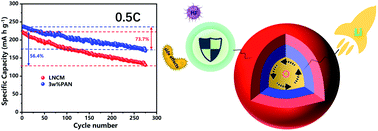Bifunctional surface modification coupled with oxygen defect engineering enables high performance Li-rich cathodes†
Abstract
Lithium-rich layered oxides are considered as the next-generation cathode material for lithium-ion batteries due to their high reversible capacity and high operating voltage. However, their commercial application is severely limited by their continuous capacity decay and voltage hysteresis. Here, we first propose to coat a layer of completely cyclized polyacrylonitrile on the surface of the Li-rich cathode Li1.2Mn0.54Co0.13Ni0.13O2, which forms a spinel layer and abundant oxygen vacancies on the surface to alleviate the above problems. As shown by the superior electrochemical performance, the specific capacity of the modified material was increased to 175 mA h g−1 with a capacity retention rate of 73.7% after 275 cycles at 0.5C. Further analysis revealed that the completely cyclized polyacrylonitrile coating can effectively reduce HF acid corrosion caused by electrolyte decomposition and stabilize the SEI film composition during long-term cycling, while the oxygen vacancies inside the material can ensure a high degree of oxygen redox; the spinel structure on the material surface effectively inhibits the structural deterioration of the material after cycling, and the stability of the transport is enhanced. The mechanism of complete cyclization of PAN and the formation of the spinel phase and a large number of oxygen vacancies was also analyzed in detail. The method has some guiding significance for the modification of lithium-rich cathodes.



 Please wait while we load your content...
Please wait while we load your content...